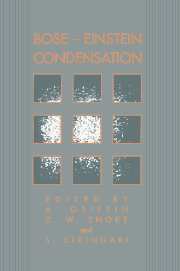Book contents
- Frontmatter
- Contents
- Preface
- Preface to paperback edition
- 1 Introduction: Unifying Themes of Bose–Einstein Condensation
- Part one Review Papers
- 2 Some Comments on Bose–Einstein Condensation
- 3 Bose–Einstein Condensation and Superfluidity
- 4 Bose-Einstein Condensation in Liquid Helium
- 5 Sum Rules and Bose–Einstein Condensation
- 6 Dilute-Degenerate Gases
- 7 Prospects for Bose–Einstein Condensation in Magnetically Trapped Atomic Hydrogen
- 8 Spin-Polarized Hydrogen: Prospects for Bose–Einstein Condensation and Two-Dimensional Superfluidity
- 9 Laser Cooling and Trapping of Neutral Atoms
- 10 Kinetics of Bose–Einstein Condensate Formation in an Interacting Bose Gas
- 11 Condensate Formation in a Bose Gas
- 12 Macroscopic Coherent States of Excitons in Semiconductors
- 13 Bose–Einstein Condensation of a Nearly Ideal Gas: Excitons in Cu2O
- 14 Bose–Einstein Condensation of Excitonic Particles in Semiconductors
- 15 Crossover from BCS Theory to Bose–Einstein Condensation
- 16 Bose–Einstein Condensation of Bipolarons in High-Tc Superconductors
- 17 The Bosonization Method in Nuclear Physics
- 18 Kaon Condensation in Dense Matter
- 19 Broken Gauge Symmetry in a Bose Condensate
- Part two Brief Reports
- Appendix. BEC 93 Participant List
- Index
16 - Bose–Einstein Condensation of Bipolarons in High-Tc Superconductors
Published online by Cambridge University Press: 15 December 2009
- Frontmatter
- Contents
- Preface
- Preface to paperback edition
- 1 Introduction: Unifying Themes of Bose–Einstein Condensation
- Part one Review Papers
- 2 Some Comments on Bose–Einstein Condensation
- 3 Bose–Einstein Condensation and Superfluidity
- 4 Bose-Einstein Condensation in Liquid Helium
- 5 Sum Rules and Bose–Einstein Condensation
- 6 Dilute-Degenerate Gases
- 7 Prospects for Bose–Einstein Condensation in Magnetically Trapped Atomic Hydrogen
- 8 Spin-Polarized Hydrogen: Prospects for Bose–Einstein Condensation and Two-Dimensional Superfluidity
- 9 Laser Cooling and Trapping of Neutral Atoms
- 10 Kinetics of Bose–Einstein Condensate Formation in an Interacting Bose Gas
- 11 Condensate Formation in a Bose Gas
- 12 Macroscopic Coherent States of Excitons in Semiconductors
- 13 Bose–Einstein Condensation of a Nearly Ideal Gas: Excitons in Cu2O
- 14 Bose–Einstein Condensation of Excitonic Particles in Semiconductors
- 15 Crossover from BCS Theory to Bose–Einstein Condensation
- 16 Bose–Einstein Condensation of Bipolarons in High-Tc Superconductors
- 17 The Bosonization Method in Nuclear Physics
- 18 Kaon Condensation in Dense Matter
- 19 Broken Gauge Symmetry in a Bose Condensate
- Part two Brief Reports
- Appendix. BEC 93 Participant List
- Index
Summary
Abstract
The short coherence lengths and the low carrier concentrations in high temperature superconductors (HTcSC) quite naturally favor a scenario where preformed bound electron pairs undergo a Bose–Einstein condensation (BEC). There are numerous experimental indications in the normal state properties (anomalous diamagnetic susceptibility, NMR spin-lattice relaxation, Knight shift and crystal electric field transitions, as well as entropy non-linear in T and strong local lattice deformations seen by EXAFS), all of which indicate a characteristic temperature Tpb associated with the breaking of such preformed electron pairs and the existence of a pseudogap above Tc. As the number of charge carriers is increased by chemical doping, Tpb decreases and the critical temperature Tc, where superconductivity sets in, in this so-called “underdoped regime”, increases. The maximum value for Tc is reached when Tc ≲ TPB. Upon further doping, going into the so-called “overdoped regime”, Tc decreases. We take this as an indication that the superconducting state depends on the existence of preformed electron pairs. The normal state properties of the “underdoped regime” seem to show significant differences from Fermi liquid behavior, while in the “overdoped regime” they seem to be typical of ordinary metals.
In order to capture this empirically established scenario in HTCSC, we discuss a phenomenological model based on a mixture of localized bosons (bound electron pairs such as bipolarons) and itinerant fermions (electrons), with a local exchange between bosons and fermion pairs.
- Type
- Chapter
- Information
- Bose-Einstein Condensation , pp. 393 - 417Publisher: Cambridge University PressPrint publication year: 1995
- 3
- Cited by

